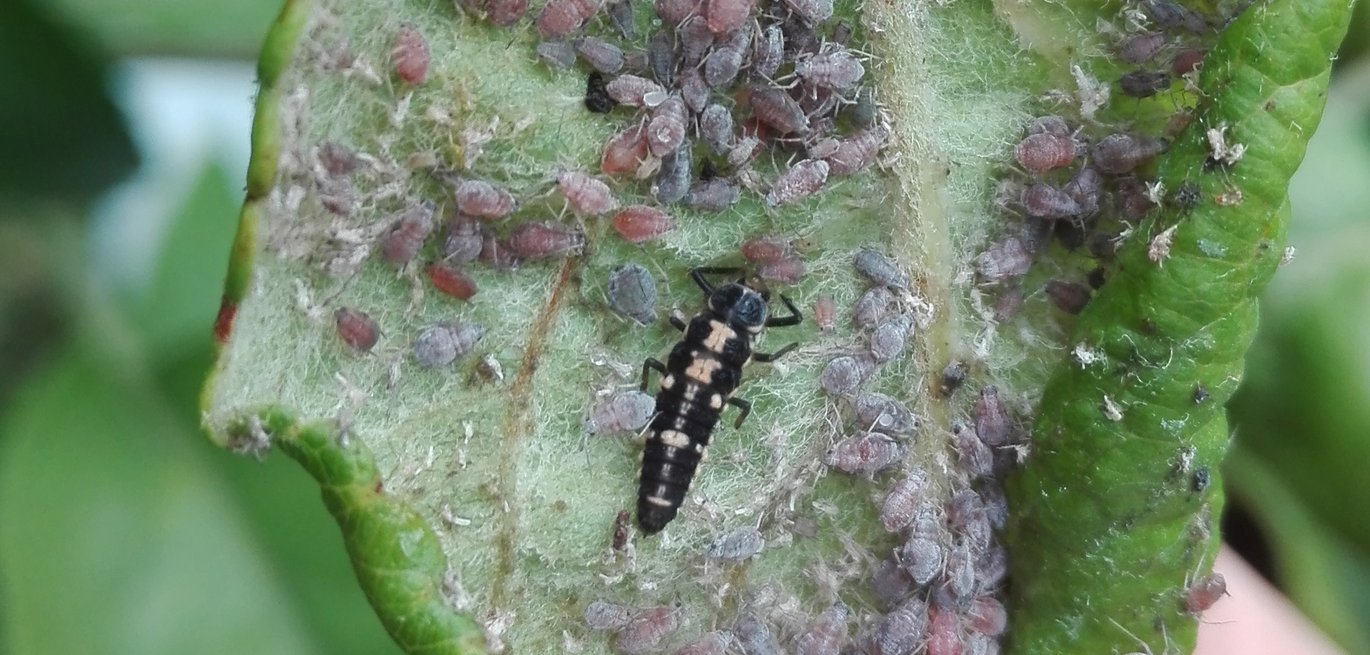Flower strips increase the occurrence of predators in organic apple orchards
Organic apple orchards often suffer great yield losses due to pests. Perennial flower strips can increase the occurrence of predators in the orchard and thereby reduce fruit damage.

In Denmark, over 20 percent of the cultivated area of apple is grown organically. Each year, growers face major challenges with pest insects, with the consequence that the majority of an average harvest cannot be sold as Class A fruit. The rosy apple aphid (Dysaphis plantaginea) is some years one of the most problematic pest species in organic apple orchards, and there is currently no control options available against this pest.
In the project ProtecFruit, we investigate whether native, perennial flower strips have a positive effect on the occurrence of natural enemies of pests, e.g. flower bugs, spiders, ladybugs, syrphid larvae and earwigs. A previous study by Lene Sigsgaard has shown that flower strips can reduce fruit damage caused by tortricids and promote the occurrence of natural enemies of pests. In addition, flower strips can benefit natural enemies by being a source of pollen and nectar and alternative prey.
We also investigated whether flower strips can reduce damage caused by the rosy apple aphid and promote its natural enemies. Therefore, in 2015, in collaboration with fruit growers, we established perennial flower strips in five orchards. In the following two years, 2016 and 17, we determined the effect of the flower strips on aphids, their natural enemies and resulting fruit damage. As a control, we did similar assessments in organic apple orchards without flower strips.
Flower strips decrease aphid and increase natural enemy occurrence
The occurrence of the rosy apple aphid was lower in 2016 than 2017. Both years, the proportion of flower clusters and long shoots with symptoms of aphids was higher in orchards without flower strips than in orchards with flower strips. This was the case throughout the period from post-flowering in May to just before harvest in August. A good abundance of natural enemies is important early in the season to avoid build-up of aphid populations. Both years, we found more natural enemies in orchards with flower strips than in orchards without flower strips. In the orchards with flower strips we usually also found more natural enemies in the tree rows adjacent to the flower strips than in rows further away. This only emphasizes the ability of flower strips to promote the occurrence of natural enemies.
More natural enemies can reduce fruit damage
Even though the abundance of aphids was relatively low in 2016, the number of damaged fruits assessed just before harvest, was still above the accepted limit for damage for conventional production. In apple orchards without flower strips approx. 6% of the apples had symptoms of aphids, and in orchards with flower strips approx. 2.5% of the apples had symptoms from aphids. In 2017, much of the harvest was unfortunately lost due to late frost in the spring. The low temperatures during the summer of 2017 also gave less activity of the natural enemies and more aphids than in 2016.
We found, by observing aphid colonies, that the most important groups of natural enemies present in the colonies were spiders, earwigs and flower bugs. In the tree row adjacent to the flower strips we observed markedly more syrphid and chrysopid larvae, which are both specialized aphid predators and very efficient enemies of aphids. The adults of both these larvae live of pollen and nectar.

Flower strips have several advantages
For these reasons, establishing flower strips can be a good solution for increasing the abundance of natural enemies. It is important to use native plant species, to ensure long flowering and to choose flowers that can thrive in the orchard, and which promote natural enemies. By this, flower strips can increase the functional biodiversity of the orchard, thus reducing the need for other pest control measures. The establishment of perennial flower strips also reduces the workload in subsequent years. To ensure the best conditions for as many plant species as possible, we recommend that the flower strips be cut twice a year, spring and autumn, after establishment.
The project ProtecFruit project is part of the Organic RDD 2 program, coordinated by ICROFS (International Centre for Research in Organic Food Systems). It has received grants from the Green Development and Demonstration Program (GUDP) under the Ministry of Environment and Food.
Contact:
Lene Sigsgaard (Department of Plant and Environmental Sciences, KU) les@plen.ku.dk, Stine Kramer Jacobsen (Department of Plant and Environmental Sciences, KU) stikra@plen.ku.dk
Visit the project website
Or visit: http://plen.ku.dk/english/research/organismal_biology/applied_entomology/